There’s a popular impression that watercolors are tricky and unforgiving. When I started out, I’d look at master watercolor paintings and wonder if I’ll ever get there!
But watercolors don’t need to be difficult…
To help you on your artist journey, I’ve put together a simple guide of the 12 easiest watercolor techniques.
Each technique is explained with simple steps, tips on how you can use them in paintings, and video references. By the end you’ll have the language of watercolor on your fingertips!
Contents
- Is Watercolor painting difficult?
- Setting Up Your Watercolor Workspace
- What are the different watercolor techniques?
- Wet On Dry
- Wet On Wet
- Flat Wash
- Graded Wash
- Color Blending
- Dry Brushing
- Lifting Off Paint
- Bleeding Colors Into One Another
- Layering Colors
- Masking Fluid & Masking Tape
- Scumbling
- Feathering
- Focus on Process, Not Perfection
Is Watercolor painting difficult?
Not at all, if you start on the right foot. Before tackling a complete painting, it is essential to get the basic foundations right. Start with simple watercolor techniques, used by even the aquarelle maestros.

Setting Up Your Watercolor Workspace
Having an organized workspace makes it easier to paint. For painting with watercolor, I make sure I have the following:
- Watercolor paper taped to a board using masking tape; this will help you to keep the sheet at an angle
- Two jars of water; one for rinsing and the other for applying clean water
- Medium and a large size brushes with soft bristles
- My favourite watercolor paints
- White ceramic bowls or palette with deep wells
- Paper towel
What are the different watercolor techniques?
There are myriad variations of watercolor techniques. Thankfully, there are just 12 basic techniques that you can build on to create any effect you desire.
I’ve broken each of these techniques into simple steps and shown how you can play and practice.
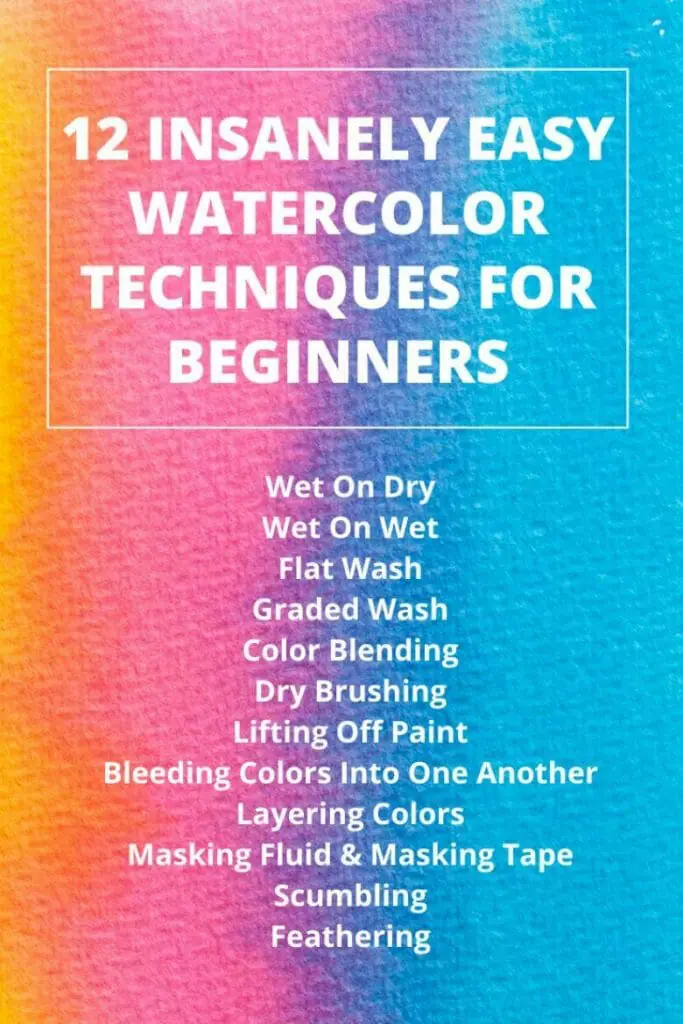
Wet On Dry
This is the easiest watercolor technique. You’ll need it to paint details, sharp edges and defined shapes. Because the surface is dry, paint will only move in the direction you pull it.

Wet on dry – stroke practice exercise
- Start with a dry surface. You’ll get different results on cold pressed and hot pressed watercolor paper.
- Moist a medium-size brush with clean water and pick up some paint. Water dilutes paint. So, experiment with the amount of water, and see how the transparency of the paint changes.
- Apply a simple shape outline, like a circle or a rectangle. Use smooth strokes in the same direction to fill it in. I like to start with small shapes, so that I can paint them quickly before it gets dry.
- When the shape is completely dry, pick up some more of the same paint and paint a smaller shape over a part of the first shape.
Wet On Wet
With this technique you’ll learn to let the watercolors do the painting for you. Wet On Wet painting techniques create flowing, abstract shapes with different colors blending into each other. Perfect for painting cloudy skies, soft shadows, distant landscapes and even flowing costumes.
Wet on wet – stroke practice exercise
- Keep your watercolor sheet at a 45 degree angle.
- Apply a generous amount of water on the painting surface.
- Pick up some watercolor with a wet brush and dab it on the wet surface. You’ll see the color blooms out to form abstract, organic shapes.
- Now, pick up some more paint and try making some short lines. Notice how all the shapes have soft, fuzzy edges.
Flat Wash
A flat wash is an even layer of paint without any variations. You’ll need to master this technique for layering colors. It works on both dry and wet paper; however I suggest trying it out on a dry paper first as it is easier to get a smooth application.
Even flat wash on dry paper – stroke practice exercise
- Mix a fairly large amount of color with water (in a 50:50 ratio).
- Start with dry paper at a 45 degree angle. Apply one stroke of paint using a large, evenly-loaded brush. I find moving my hand from the shoulder, in one fluid motion, creates even strokes. I also keep my brush parallel to the paper.
- You’ll see a bead of color gathering at the bottom of the stroke. Apply another stroke. Touch the edge of your first stroke and gently gather and spread that bead of color.
- Keep repeating this until you have an evenly colored spread on the paper. If your brush becomes too dry, pick up some more of the color mix. Blot your brush on a paper towel, so that it is evenly loaded.
- At the end of your wash, you’ll notice a bead of color at the bottom. Take a dry brush and soak up this bead.
Graded Wash
A graded wash moves from dark to light. You’ll find this useful for sunrise paintings, illustration backgrounds and distant landscapes. Similar to a flat wash, you can paint with watercolor on both dry and wet surfaces.
Dark to light wash – stroke practice exercise
- Load a large brush with thick, wet paint. And, just drag it across dry paper.
- Dip your brush in water and rinse it slightly. Now apply another horizontal stroke touching the first stroke. Dilute the paint by adding water for each stroke.
- For the last few strokes, use clear water and the color from the previous stroke. This will create the lighter tones. The color should get lighter with every stroke.
- End with mopping up the extra color.
Color Blending
Graded wash and color blending are similar watercolor techniques. However, with color blending, you slowly blend one color with another. I use this technique to show the changing colors during sunrise and sunsets.
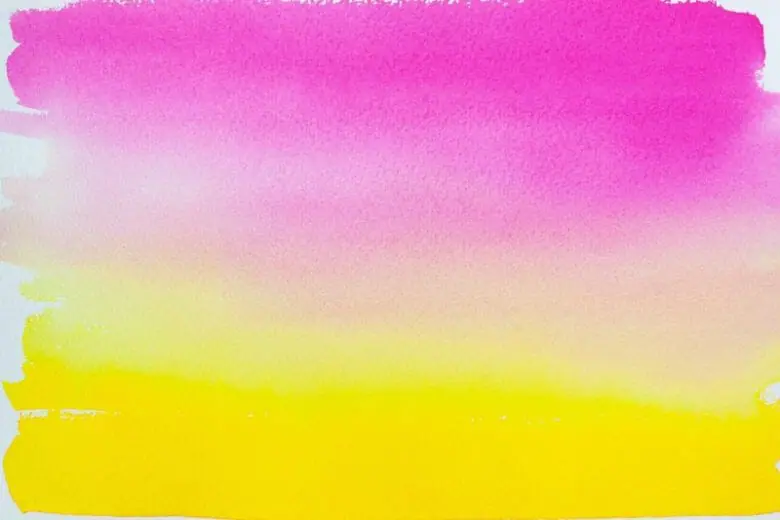
Mixing two colors – stroke practice exercise
- Pick two colors. Start with the first color, and move down, slowly adding more water. Keep your strokes smooth and in one direction.
- Then, we pick the second color. Paint from the bottom, and keep adding more water as you paint up (towards the first color). The two colors should meet in the middle.
- If the surface is still wet, both colors will blend together beautifully. To control the blending, gently apply a stroke of clean water.
Tip: Pick colors that complement each other to avoid muddy areas. Yellow and green, blue and green, and red and orange are some good color combinations.
Dry Brushing
One of my favourite techniques to use with cold press paper texture is dry brushing. The textured marks work really well to indicate fur, wood, rough ground, and reflections on water.

Experiment with texture – stroke practice exercise
- Make a thick paint mix.
- Use a dry, flat brush to pick the paint, blotting it to ensure it remains dry.
- Softly, sweep the brush across at an angle.
- You’ll find it creates an interesting texture. Experiment using this technique on dried watercolor washes.
Note: With this technique, the color won’t lighten on drying.
Lifting Off Paint
You’ll want to lift paint sometimes, to create highlights or correct a stroke. Thankfully, there are two effective ways to do this.
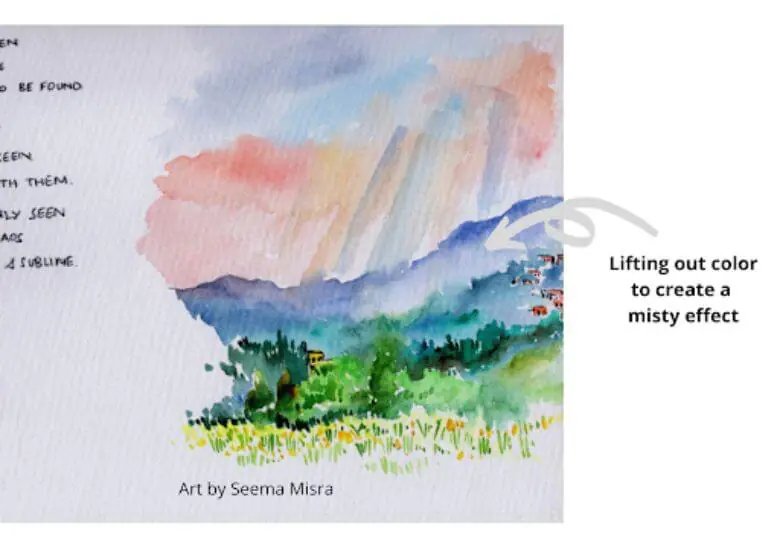
Lifting Off Wet Watercolor
- Dry your brush on tissue or cloth and touch it to the area where you want to lift the color.
- You’ll find the dry bristles soaks up the color. Repeat, if needed.
Tip: To lift large, abstract patches (for clouds on the sky) I use a crumpled bit of clean tissue paper.
Lifting Off Dry Watercolor
- Apply clear water on the surface.
- Wait for a few seconds, and then lift the color with a dry brush or a tissue. You’ll need to be very gentle and soft, to avoid tearing the sheet. Using 100% cotton watercolor paper helps!
Bleeding Colors Into One Another
Bleeding is a slightly more complex version of wet in wet technique, where you’ll get spontaneous blends of colors.
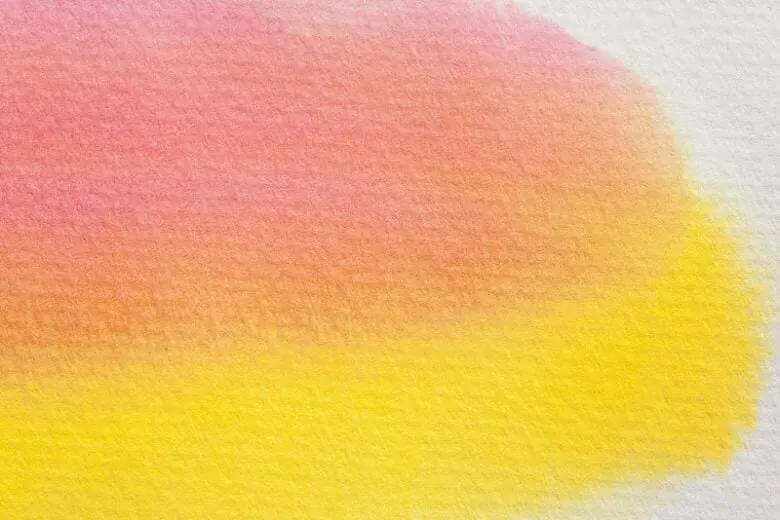
Play with colors – stroke practice exercise
- Use two complementary colors, like Quinacridone Rose and Ultramarine Blue. Mix in some water, aiming for a milk like consistency for both colors.
- Now, apply some Quinacridone Rose to a wet surface. Wait for a few seconds while the color spreads out.
- Then, with a clean brush apply the Ultramarine Blue within the first wash, preferably at a corner. You’ll find that both colors blend in creating subtle gradients.
Layering Colors
Layering, also known as glazing, is used to make detail oriented, and slowly done paintings with watercolors. It is one of the more time consuming techniques.

Layer colors – stroke practice exercise
- Apply a layer of light, wet paint on white paper. Use any color of your choice and remember to use a large amount of water, as the first layer should be very light.
- Once the wash is completely dry, take a different color (watered down) and apply two to three strokes on top of the first wash.
- Once the layer is completely dry, add another layer. Keep building layers, using the same or different colors, to create color variations and values.
Note: It is essential that the paper is absolutely dry, so that the colors don’t blend and get muddy. Many artists use a hairdryer to speed up the process.
Masking Fluid & Masking Tape
Do you find leaving those white paper highlights difficult while painting watercolor? That’s where masking fluid and masking tape watercolor techniques come in use.
Using Masking Fluid Techniques
Masking fluid is a beige or blue rubbery fluid.
- Apply the masking fluid to those areas of your subject that get maximum light.
- Use a cheap brush or a nib to apply the fluid. Let it dry.
- Now continue with your painting. Once the paint has dried out, you can remove the masking fluid for pure white highlights.
Using Masking Tape Techniques
Masking tape is very useful to secure your paper to the board and create a clean boundary for your artwork. You can even use the tape to block the horizon line, which is very handy in landscape watercolor painting.
Scumbling
Scumbling is a watercolor painting technique used to create a textured effect, add depth and mood to a painting, or smoothen transition from one color to the other. You’ll find this watercolor technique very useful for painting foliage.
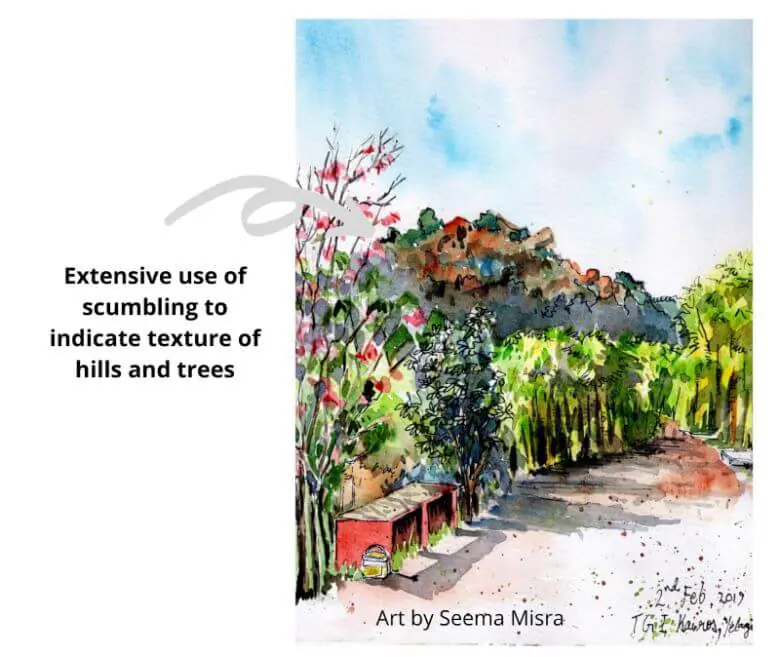
Making scumbling marks – stroke practice exercise
- Take a fairly loaded round brush and apply sporadic rounded marks. Hold your brush almost parallel to the surface for spontaneous paint marks.
- Make bouncy, slightly scrubby movements with a delicate touch.
- You can let the layer dry and then add in another color, or use a wet on wet approach.
Feathering
Sometimes you will want to soften the edges of a wash while painting by watercolor. To convey far away, misty shapes like ships on the horizon. Here’s where you can use the feathering technique.
Soften hard edges – stroke practice exercise
- Apply a flat, thick stroke of color in a rectangle shape. Now, choose one edge that you want to lose.
- Take a medium brush with clean water and dab off extra moisture. Now, apply a clean stroke of water near the edge that you want to soften.
- Glide the tip of your brush very softly along the edge. You’ll find it spreads out into the color, with the sharp edge blurring out.
Focus on Process, Not Perfection
Practice these watercolor painting techniques by using them to paint simple objects, like fruits or coffee mugs. Be fearless and just have fun with the watercolor painting process.
Don’t worry about making mistakes, it’s all part of the learning experience.
And, comment below, what is your favourite watercolor technique?


